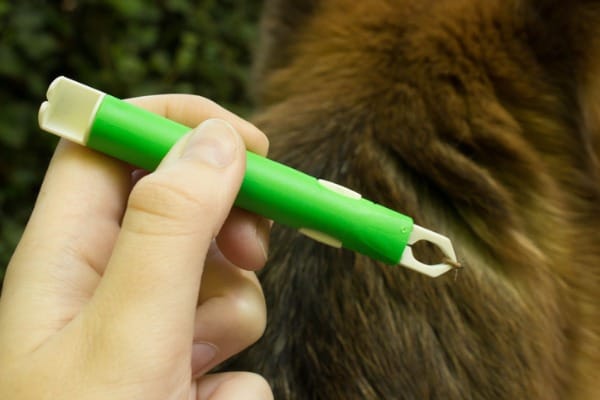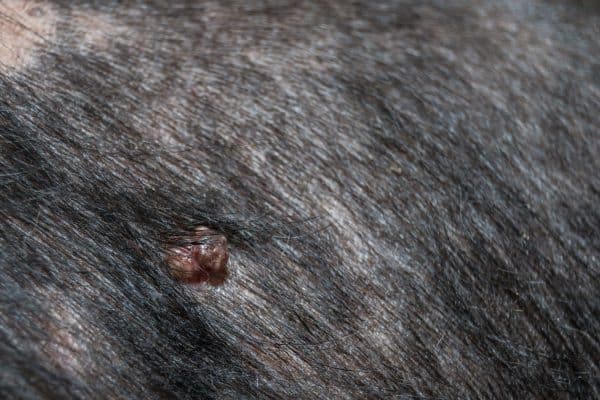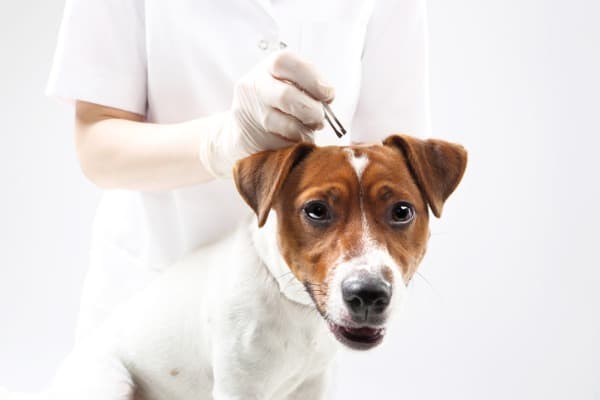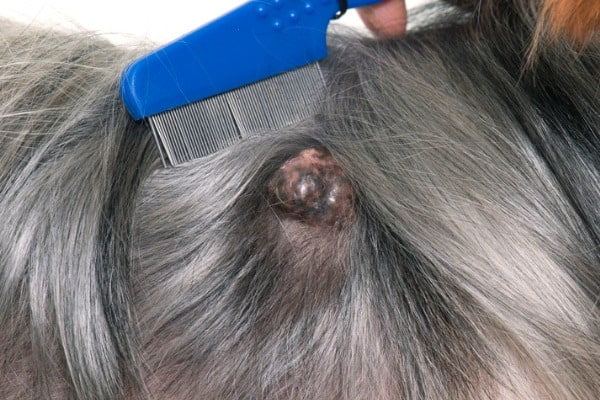
Skin conditions exist with dogs as much as they do with humans.
The biggest difference?
Depending on the breed, dogs have a layer of fur or hair covering their skin, making it harder to notice changes in their skin.
However, sometimes something that’s impossible to miss pops up on your dog.
Skin tags, for example, are something you’re likely to notice either because it’s in a conspicuous spot or you feel it when you pet your dog.
What’s the deal with skin tags?
The good news is if it’s just a skin tag, it’s rarely something to rush to the vet over.
A skin tag on your dog turning black, appearing infected, or bleeding is a different story.
So what should you do?
We’ll cover what to expect at the vet’s office, how you can manage the problem at home, and what to do when it’s not a skin tag at all.
Key Takeaways
- Differentiate between skin tags and ticks by looking for legs; consult a vet for any uncertainties.
- Visit a vet for skin tags that change color, bleed, or look infected and for any suspicious growths.
- Avoid home removal of skin tags to prevent pain, infection, and misdiagnosis; seek professional help.
- Keep your dog healthy to reduce skin issues by fitting wearables correctly, balancing bathing, offering a nutritious diet, limiting chemical exposure, and regularly checking the skin.
Identifying a Skin Tag

First things first – you might be dealing with a nasty little parasite as opposed to a skin tag.
We’re talking about ticks:
Not only do they love to attach themselves to dogs, but they also can look like a skin tag at first glance.
Ticks that have just attached themselves usually look black, dark red, or dark brown in color.
They’re quite small and can easily be mistaken for a skin tag.
Bloated ticks turn lighter in color as they feed, eventually turning gray or light tan.
Full-sized ticks are around the size of a kernel of corn or larger and are also sometimes mistaken for a skin tag.
Why is it crucial to differentiate between a skin tag and a tick?
Ticks can carry some diseases that can make your pup seriously ill, and getting them out before they start to feed is the best line of defense to prevent infections from transmitting.
Even if they’ve had a chance to fill up on your dog’s blood, you’ll want to detach and identify it as soon as you can, to see whether or not it’s a disease-carrying species.
So, how do you know it’s a tick versus a skin tag on your dog?
It’s time to overcome the creepy crawlies and get a close look at the suspected skin tag.
The most apparent difference between those and ticks is that skin tags don’t tend to have legs.
Yes:
You’ll probably be able to see the tiny legs on a tick, giving you the green light to remove this visitor on your dog’s skin.
A magnifying glass is sometimes needed to see the legs on a tick if you’re not totally convinced it is indeed a tick.
It doesn’t have to be a strong one, just something to help you get a closer look.
It’s Not a Tick. Now What?
If you’ve determined that the thing on your dog is indeed part of your dog’s skin and not a parasite, then you’re probably wondering what it is.
If it’s similar to your dog’s skin color, fleshy, and appears to be attached to the skin by a small “stalk,” then you’re probably dealing with a skin tag or acrochordon.
You don’t have to touch it if you’re weirded out by it, but if you do, it’ll feel soft and squishy.
It shouldn’t cause your dog pain or discomfort if you touch it, but if it does, it needs to be evaluated by a vet.
You might notice it because it’s dark, a different color from your dog’s skin has a scabby appearance, or is bleeding.

This doesn’t eliminate the possibility that it’s a skin tag, although these circumstances require a vet’s care.
A skin tag that doesn’t seem to be infected, open, or discolored is likely just that – a skin tag.
What if your dog has dark or black skin – this means a normal skin tag would be black, right?
Dogs with dark or black skin will indeed have similarly colored skin tags.
There are some serious conditions that also look like black skin tags, which is another reason to have the vet double-check the spot.
A skin tag can appear just about anywhere on your dog’s body, although the belly, legs, and armpits are slightly more common areas where you might find a skin tag.
There can be one skin tag or several in the general area.
Skin tags don’t discriminate by breed:
They can and do crop up on any dog breed or size.
They are more common in older and elderly dogs but can appear on a dog of any age.
However:
They can be more noticeable on short-haired dogs.
A thick-coated, fluffy Alaskan Malamute might have a skin tag on their body that goes unnoticed, while a skin tag on a Pug would be seen right away.
A skin tag can seem to appear overnight out of nowhere, but that doesn’t mean it’s dangerous.
We’ll cover how to handle this skin issue next.
Treating Skin Tags

Skin tags are common issues and can affect any dog, but you should still have a vet look at them.
Are they dangerous to your dog’s health?
No.
However, some potentially serious conditions can be misdiagnosed by the untrained eye as a skin tag.
Even if it’s a benign spot:
It can become opened up or detached by your dog scratching or playing.
Skin tags near the eyes, mouth, and nose can also pose some problems by interfering with your dog’s eating, breathing, and vision.
That doesn’t mean you need to rush off to the emergency vet if you notice a skin tag on your dog, though.
If it’s simply a skin tag that is not discolored, then you should monitor it closely until your dog’s next appointment with the vet.
If it changes in size, color, bleeds, or shows signs of infection, that’s when you should inform your vet.
Also:
Be aware of how your dog deals with a skin tag.
They’ll probably ignore it entirely.
If they dig or bite at it, it could be causing them discomfort – and that can point to a separate issue.
If the skin tag hasn’t changed by the time your vet has a look at it, they will likely tell you to keep monitoring it for changes and otherwise leave it alone.
Most vets will forego removing a skin tag that isn’t interfering with your dog’s day-to-day life.
In typical skin tags, removal is purely for aesthetic purposes – otherwise, it’s unnecessary to remove them.
Removing a skin tag at the vet’s office would involve cutting it, cauterizing it, or freezing it off through cryotherapy.
The catch?
Each option would require your dog to be anesthetized and sedated.
The vet might offer you the option of having it removed the next time your dog is already sedated, like during a dental cleaning.
If you want the skin tag gone from your dog but don’t want to wait for the vet to deal with it, are there ways to remove them at home?
There’s always a DIY for these things, but we strongly advise against using them.
If the suspected skin tag hasn’t been diagnosed by a vet, removing it at home would risk removing something which needs to be biopsied.
If the skin tag is really skin cancer, removing it using a DIY method certainly won’t make your dog cancer-free – that’s something only the vet can attempt.
What are the other risks, even if you know it’s a skin tag?
Don’t tie it off, don’t cut it, and certainly don’t pull it off.
It will cause your dog unneeded pain and discomfort, and it will raise the risk of infection.
Ask yourself this:
If the skin tag was on you, would you be willing to do any of those things instead of letting a qualified dermatologist handle the problem?
Hopefully, you answered no, but even if you were willing to self-treat this condition, spare your beloved dog the risks that come with doing so.
Spare your bank account, too – an infection will be more expensive to treat than letting the vet take care of the skin tag.
Sometimes a skin tag will get ripped off accidentally.
It can happen while your dog is playing or if they scratch at it.
This can be a scary, bloody mess, but don’t panic.
Your dog is highly unlikely to lose a dangerous amount of blood from a torn skin tag.
You will want to inform your vet if a skin tag has been torn off; they’ll be able to advise whether or not your dog needs to come to the office.
What Else to Look Out For?

Sometimes, it’s not a skin tag – it could be skin cancer or a mast cell tumor.
When you have a suspected skin tag evaluated by a vet, they can give you a clear answer about which one it is.
What if a new spot has cropped up on your dog, and you’re not sure it’s a skin tag?
A good thing to remember is that melanomas tend to be flatter against the skin of a dog, rather than hanging away by the “stalk.”
Don’t forget that anything that isn’t similar in color to your dog’s skin is a red flag for a more serious issue.
Skin cancers in dogs crop up around the mouth, between the toes, and on the paws.
Luckily:
When it comes to skin cancer in dogs, they can often be treated through removal without involving chemotherapy or radiation.
The key is catching them as soon as possible, which is all the more reason to get a suspicious spot checked out by a vet.
Can I Do Anything to Prevent Skin Tags on My Dog?
There’s no sure answer to why skin tags develop on dogs – or any other mammal, for that matter.
There are some things that are connected to this skin issue. However, avoiding them can help lower the risk of new skin tags showing up.
Keep the Collar Comfy

All collars, harnesses, bandannas, sweaters, etc., should be fitted so they don’t rub on your dog’s skin.
Better yet:
Remove them when they’re not needed, and give your dog’s skin a break.
Balance the Bathing
Overbathing your dog can cause a variety of skin issues aside from raising the risk of skin tags developing.
It can strip the natural oils from your dog’s coat, and cause itchiness, dry skin, and even skin infections.
On the other end of the spectrum, not bathing enough can cause issues of its own.
There’s no one-size-fits-all formula for how often you should bathe a dog since every dog is different.
However, there are some basic guidelines based on the breed and coat type of your dog.
Feed Them the Good Stuff

A balanced diet will benefit your dog’s entire body, skin included.
Steer clear of cheap food brands with lots of starchy fillers, and stick to trusted, nutritious formulas.
Also, keep table scraps and junk food to a minimum.
Avoid Chemicals
It’s not easy to limit exposure to irritants when they seem to be in everything.
Keeping your dog away from them can be even harder, but it can protect them from a variety of skin conditions, including skin tags.
Pesticides on lawns, harsh cleaning substances, and even strong shampoos can throw your dog’s skin out of whack.
Remember:
Always use dog-safe shampoos, and try to avoid heavy-duty detergents in the house unless absolutely necessary.
When in Doubt, Check it Out
Or let the vet check it out.
New, unusual spots on your dog’s skin warrant a look at a vet at some point or another.
When should you take immediate action?
A black skin tag on your dog’s leg or finding blackheads on their belly, for example, should be evaluated quickly.
Bleeding, painful, infected, or growing spots also aren’t something to ignore.
When it’s just a standard-issue skin tag that doesn’t change, it’s best to leave it alone. Unless it affects your dog’s lifestyle, it won’t pose serious threats to their health.
Frequently Asked Questions
What should I do if I find a black skin tag on my dog?
If you discover a black skin tag on your dog, closely monitor it for any changes in size, color, or behavior (bleeding, infection). Consult a veterinarian for a professional evaluation to ensure it’s not indicative of a more serious condition.
How can I tell the difference between a skin tag and a tick on my dog?
To differentiate between a skin tag and a tick, look for the presence of legs, which ticks have and skin tags do not. A magnifying glass may be helpful for a closer examination. When in doubt, seek veterinary advice.
Is it safe to remove a dog’s skin tag at home?
Home removal of a dog’s skin tag is not recommended due to risks of pain, infection, and potential misdiagnosis of the growth. Professional veterinary assessment and removal are the safest options.
Can a skin tag indicate cancer in dogs?
While most skin tags are benign, certain changes in their appearance, such as rapid growth, bleeding, or color change, may necessitate a veterinary check to rule out cancer or other serious conditions.
How can I prevent skin tags from forming on my dog?
While the exact cause of skin tags is unknown, maintaining your dog’s overall health can potentially minimize their occurrence. This includes using properly fitted collars and harnesses, managing bathing frequency, feeding a nutritious diet, and limiting exposure to harsh chemicals.
What are the common signs that a skin tag on my dog needs veterinary attention?
Signs that warrant veterinary attention include changes in the skin tag’s color, size, the occurrence of bleeding or infection, and if it causes discomfort to your dog. When any of these signs are observed, a vet visit is advised.
